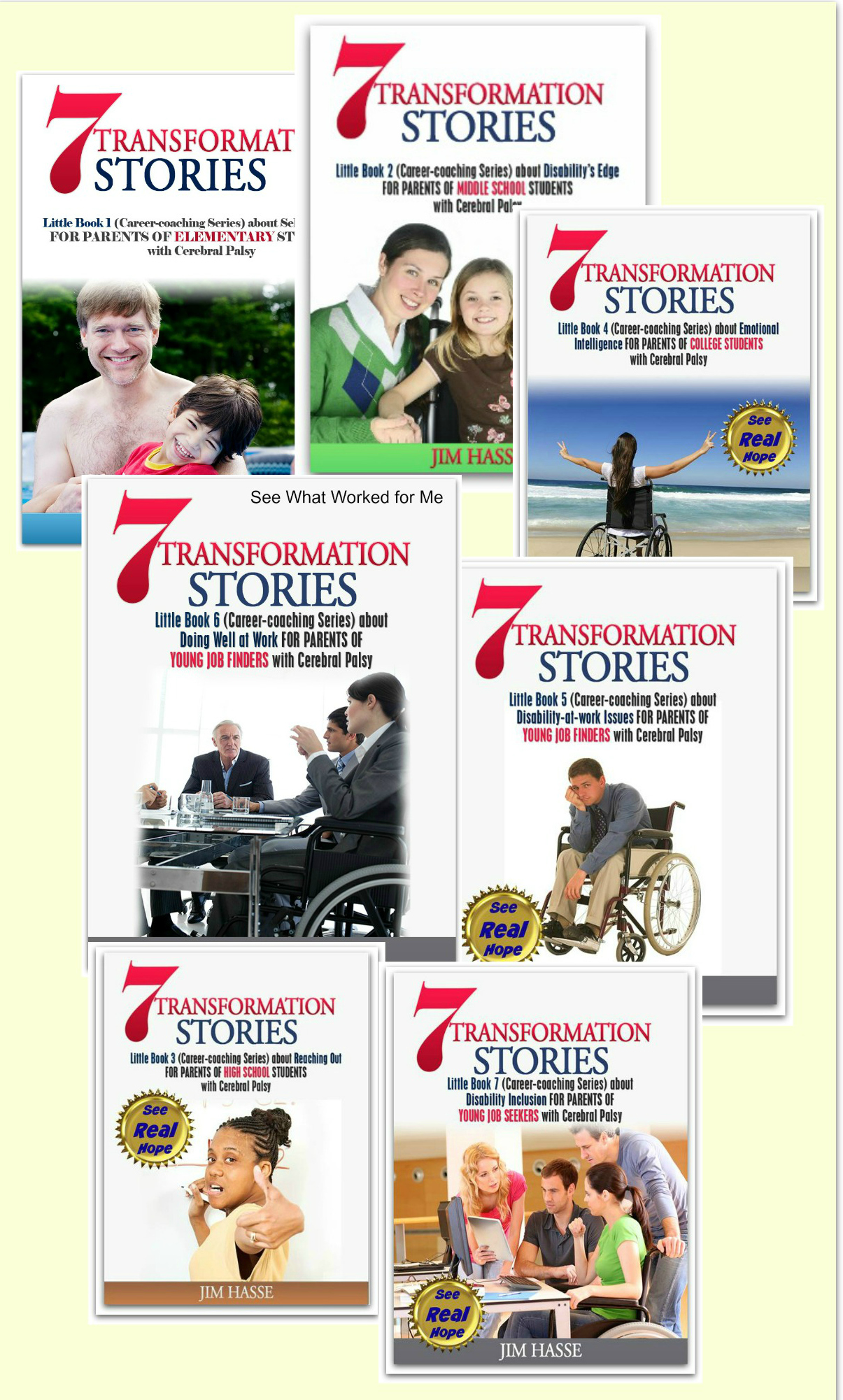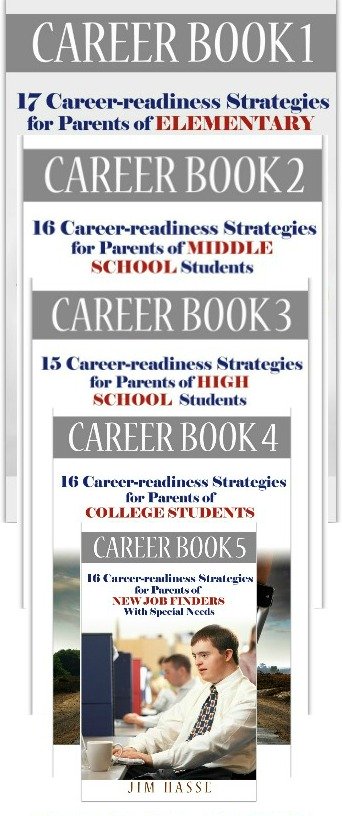Job Search Tips: Cerebral Palsy
Career Builder for High School Students
By Jim Hasse, ABC, GCDF, Disability Employment Expert
_________________________________________________________
Here are six job search tips to pass along to your high school student with cerebral palsy (CP) that may be helpful now in finding part-time work. They will certainly be essential for making the transition from school to work 10 years from now.
How does your high school
youngster get a part-time job while still in school? Consider the overall strategy
of the six tips which follow. They basically boil down to this: Uncover mainstream work situations
which offer reduced competition from other job seekers.
Debra L. Angel and Elizabeth E. Harney, authors of "No One is Unemployable: Creative Solutions for Overcoming Barriers to Employment," advise those with disabilities to seek opportunities within the most receptive environment for developing their careers.
This strategy involves uncovering situations which offer reduced competition from just-as-qualified, non-disabled candidates. Pursuing that strategy, according to the authors, will increase the likelihood that your youngster will land a part-time job or eventually an entry-level job that is right for him or her.
A job is right for your youngster when it empowers him or her to work at tasks that eventually could become a vocation.
In other words, your youngster needs to learn now how to choose the most receptive environment for developing a career. That insight is not an ivory-tower theory. It’s based on bed-rock experiences.
During the last decade, I’ve noticed a range of comments and recommendations from employed persons with a disability which basically echo what Angel and Harney are saying: "Be flexible in where you look for a job."
Specifically, what does that strategy (if you agree that it has at least some application to your youngster’s situation) mean in terms of deciding which job search tactics to use?
Here are some options (six job search tips), generated
by the observations from those job holders and job seekers with disabilities I’ve
been tracking during the last 20 years.

First of six job search
tips
Your youngster will need to concentrate his or her job search within the hidden job market where 80 percent of the available jobs become available but only become known to 20 percent of the job seekers because they hear about them through personal networking.
For example, KH, who apparently helps individuals who are visually impaired
manage their careers, recommends:
"Network with as many people as possible when looking for a
job, even if you don't think they can be of any help to you. You never know.
That individual might be able to put you in contact with an employer."
What’s your tip for
helping
a youngster gain summer-time work experience?
Join PACER’s Facebook
discussion.
Second of six job search tips
Your youngster needs to avoid industries and jobs where his or her particular disability can be a major real -- or perceived -- barrier.
A self-described "empowered" individual, I.V., offers this insight:
"If you want to work within a certain distance from your home and are not successful, you might want to expand the territory.. . You may also need to have some flexibility in the type of job you are looking to get."
Third of six job search tips
Your youngster needs to learn how to be resourceful in locating companies which are already familiar with the value of physically disabled employees. Over the next few years, help your youngster visit with the HR directors of larger companies on an informal and formal basis to find out if they currently employ people with disabilities and ask what types of jobs they hold.
Here are two ideas for pinpointing high-potential employers who hire individuals with disabilities:
- Skip job fairs with a
broad disability focus. Instead, search for job fairs specifically for job
candidates with your specific disability (from M.A.).
- Compile a list of companies (with people to contact) which have expressed an interest in hiring individual with disabilities as interns -- such as you’ll find on GettingHired.com (from D.L.).
Fourth of six job search tips
Your youngster’s job search (either for a part-time job or as an eventual school-to-work transition) can be positioned as a research project. A barrier to one employer may not be a barrier to another. So, identifying the employer's perception of various barriers occurs throughout the job search process as your youngster approaches new employers.
Each prospective hiring manager offers an opportunity to turn a perceived barrier he or she sees in your youngster into a selling point for why a job offer makes good business sense. If a specific employer is not receptive to your youngster due to CP, it’s time to move on. There are other opportunities waiting.
K.B., for example, is apparently a college student and has a good grasp about
negotiating accommodations with receptive employers. It's a two-way street,
K.B. writes, adding:
"Be up-front with people about what you
need. For example, inform your employer about what kinds of accommodations you
will need to access a computer.
Fifth of six job search tips
Remember that companies are in business to make money. If a job seeker can prove that he or she can make money for a company (in exchange for being paid as an employee), CP or any other type of physical disability will likely be ignored as a perceived barrier.
Here's J.L.'s comment, which shows an understanding of how to create win-win situations in employee-employer relationships:
"I volunteered as an accountant for a non-profit and discovered a way to save $5,000 a year in delivery services. I used that example to get my current cost accounting job for a cheese processing firm.”
Sixth of six job search tips
Your youngster can even consider creating his or her own job function -- and marketing it to the right company. That involves showing a hiring manager how a specific need is not currently being met – an added function that makes business sense. Who can best fill that need? Your youngster, of course, who can help that individual ease a pain or attain a gain.
M.B.'s comment pinpoints a prerequisite for creating a job within an organization or company:
"Make yourself an expert in an area where experts are needed. If you are an expert and if you are needed, then you will have a much easier time."
I'd also like to add this bit of advice for your high school student:
"Approaching your job search from both a research and marketing perspective enables you to change where you look for the best employment opportunities in a part-time job (which is probably your goal at this stage in your career). It gives you flexibility. It gives you freedom."
Which one of these tactics will resonates with your youngster – now and in the future when job hunting will get to be a serious undertaking?
Now’s
the time to test each of the job search tips with your youngster. Talk about
them. Which of them hold the most promise for eventual success? Note when
others get hired because they’ve used one or more of these job search tips –
and approach job hunting from a research and marketing perspective.
What’s your tip for
helping
a youngster gain summer-time work experience?
Join PACER’s Facebook
discussion.
Return
from Job Search Tips to Part-time Jobs
Go
to Cerebral Palsy Career Builders
This is Creative Commons content. You can freely and legally use, share and repurpose it for non-commercial purposes only, provided you attach this sentence and the following attribution to it (including the two links):
Originally written and illustrated by Jim Hasse, ABC, GCDF, owner of Hasse Communication Counseling, LLC, who, as a person with cerebral palsy, served for 10 years as a vice president in a Fortune 500 company during his 29-year career in corporate communication. He’s an Accredited Business Communicator, certified as a Global Career Development Facilitator and author of 14 Amazon books about disability awareness and disability employment issues.





